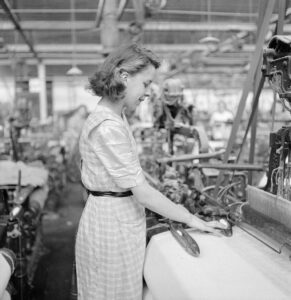We had a very enjoyable and interesting visit to the last surviving 19th Century steam powered weaving mill in the world. This Grade 1 listed building has a mighty steam engine re named Peace after ww1 armistice, originally it was named Prudence and had a coal fired boiler. The mill is deemed to be of national importance.
We learnt about pirn winding and drawing in. There are 308 looms in the shed at present, originally there were over 900. All the looms were bought from two Burnley companies and have not been replaced. Cloth was taken by horse and cart and railway to the finishers, for dyeing and bleaching. Only in 1910 was the horse and cart replaced by steam powered lorries.
Weavers were paid by piecework; a good four-loom weaver was paid 24 shillings a week, only slightly less than a tackler. Harle Syke workers had always been paid slightly below the list, which management explained as being due to the carriage costs to Burnley. In August 1915 there was a strike that lasted for several weeks triggered by this injustice.

15yr old Mona at a cotton mill in Lancashire. 1945. Public Domain
We learned about various steps in the manufacture of cotton and the duties of various staff, from the boiler room to the engine room,
Did you know..?
..About the tape sizer who fell down dead? His workmates instantly searched his pockets for the formula.
That weavers were to busy to have a break for mealtimes and would keep a bucket of boiling water to cook their lunch at the end of the loom?
That people “.. had no choice but to work in the mill.. If we’d have gone into service we wouldn’t have brought in enough money and to work in the shops you needed shoes and we only had clogs. But I’ve no regrets. I loved my time at the mill.” Mrs Catherine Carter.
Banner Image:Attribution: Journal of Victorian Culture, courtesy of Stephen Irwin.